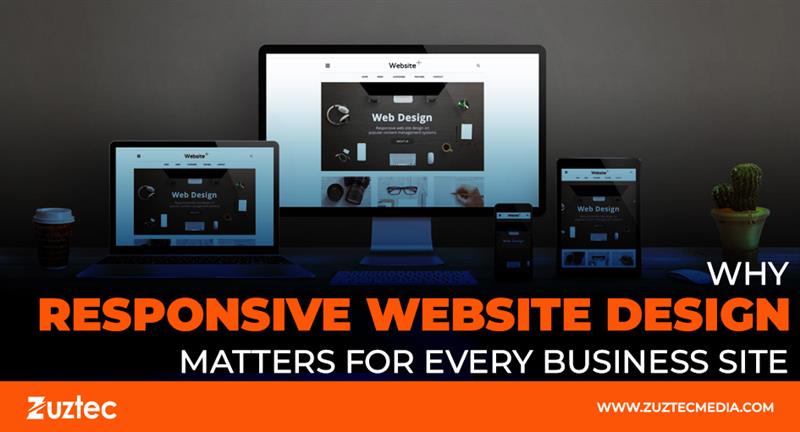
Why Responsive Website Design Matters For Every Business Site
Users demand that websites load rapidly, look good, and work properly on all devices in today’s fast-paced digital world. With the increasing variety of smartphones, tablets, laptops, and desktops, designing a one-size-fits-all website is no longer effective. This is where responsive website design becomes essential. It’s not just a trend—it’s a requirement for any business that wants to succeed online.
It ensures that a site adapts seamlessly to various screen sizes and resolutions. Whether a customer visits your site from a mobile phone in a coffee shop or from a desktop computer in an office, the experience should remain smooth and consistent. A responsive layout automatically rearranges and resizes content, images, and navigation to fit different devices without requiring multiple versions of the site. If visitors can’t navigate your site easily or read your content on their phone, they’ll likely leave and go to a competitor. In contrast, a well-designed responsive site keeps users engaged and encourages them to take action, whether it’s signing up for a newsletter, making a purchase, or contacting your team.
A responsive site is not only more accessible to users but also favored by search algorithms, which can drive more organic traffic to your business. As mobile usage continues to grow, companies that fail to invest in responsive design risk falling behind. It’s not just about aesthetics—it’s about functionality, accessibility, and long-term digital success.
Responsive Website Design Improves Accessibility And User Experience
It is a technique for creating websites that adapt to different screen sizes and devices automatically. This guarantees that users, whether using a desktop, laptop, tablet, or smartphone, will always have a simple and consistent experience.
With so many people accessing websites from mobile devices, your site must be accessible on smaller screens. Responsive websites eliminate the need for users to pinch, zoom, or scroll awkwardly to view content. Navigation menus, buttons, images, and text all resize appropriately for the best possible experience.
A user-friendly experience can reduce bounce rates and increase the time users spend on your site. It also increases the likelihood of conversions. Whether your goal is to sell products, gather leads, or share content, responsive design plays a key role in making sure users stick around and take action.
Boosting Seo And Reaching More Users Across Devices
Another area where responsive design makes a significant difference is search engine optimization (SEO). Google now indexes and ranks websites primarily using their mobile versions, a practice known as mobile-first indexing. Your website will probably rank lower in search engine results if it is not mobile-friendly.
Responsive design helps maintain consistent content across all devices, which avoids issues of duplicate content that can harm SEO. It also allows faster page loading times, which is another key factor in search rankings. Users are less likely to abandon a site that loads quickly and functions well.
Additionally, with one responsive website design instead of separate mobile and desktop versions, businesses can streamline their SEO efforts. All traffic, backlinks, and content are directed to a single URL, improving authority and making site maintenance easier. This unified approach is more effective and efficient in the long run.
Responsive websites also support improved sharing and link consistency. When someone shares a link from their mobile device, the recipient on a desktop or tablet sees the same content formatted correctly for their device. This enhances the reach and usability of shared content.
Saving Time And Money With A Future-Proof Solution
It is far less expensive to create and manage a single responsive website than to create and manage separate desktop and mobile versions. A single responsive design simplifies your workflow, reduces development time, and lowers long-term maintenance costs.
Since responsive sites are built with scalability in mind, they are easier to update and expand as your business grows. Whether you want to add a new section, launch a campaign, or integrate third-party tools, a responsive framework can handle those changes smoothly without needing major adjustments for different devices.
Furthermore, with rapid changes in screen technology and device sizes, responsive design helps future-proof your site. Instead of redesigning your website every time a new smartphone or tablet hits the market, your site will adapt automatically. This long-term adaptability makes responsive design a wise investment for businesses looking to stay ahead.
Henceforth, responsive website design is no longer optional—it’s a necessity for businesses that want to stay competitive in the digital age. It ensures that your website performs well across all devices, provides a better user experience, improves your SEO efforts, and saves time and money over the long term. As user behavior continues to shift toward mobile-first browsing, investing in responsive design is one of the smartest decisions you can make. A site that adjusts to the needs of your users is a site that works better for your business. Let responsive design lead the way in building a stronger online presence.

